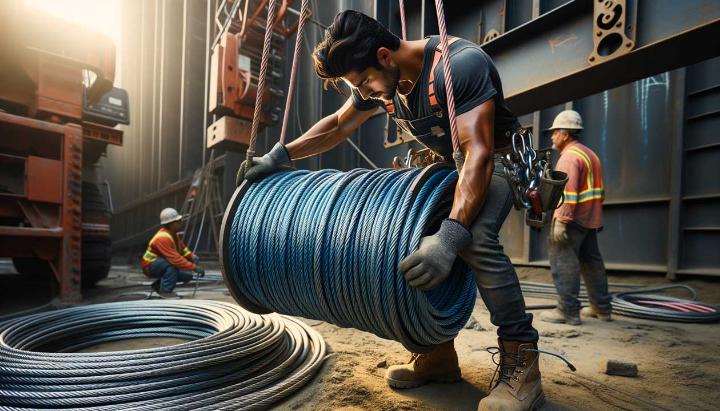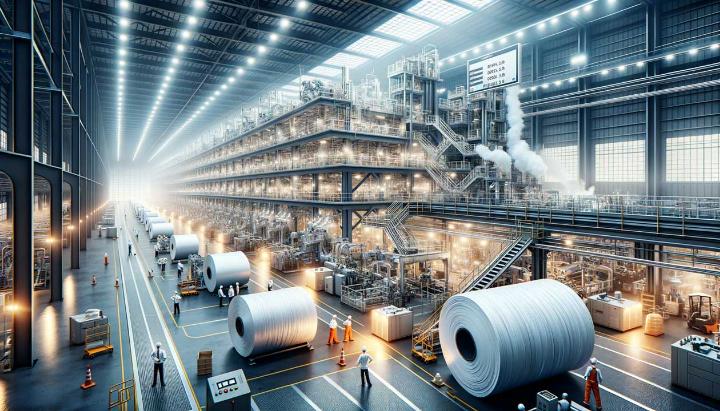Imagine a world where cables are stronger than steel, yet light enough to float on water. It's not science fiction—it's the reality of Ultra-High-Molecular-Weight Polyethylene (UHMWPE). This revolutionary material is rapidly replacing traditional 6mm steel cable across industries, from off-road adventures to heavy-duty lifting operations.
But why is UHMWPE causing such a stir? Picture this: a cable that's up to 15 times stronger than steel by weight, resistant to chemicals and UV rays, and flexible enough to handle the toughest conditions. It's no wonder that manufacturers and industry professionals are making the switch.
In this post, we'll delve into the remarkable properties of UHMWPE and explore how it's outperforming 6mm steel rope in various applications. We'll uncover the reasons behind its growing popularity in off-road vehicles, lifting and rigging operations, and even environmentally conscious industries. Whether you're a seasoned professional or simply curious about the latest in material technology, you're about to discover why UHMWPE is not just an alternative to steel—it's the future of cable engineering.
Comparing UHMWPE and 6mm Steel Cable Properties
When it comes to choosing the right material for cable applications, the debate between UHMWPE (Ultra-High-Molecular-Weight Polyethylene) and traditional 6mm steel cable has been heating up in recent years. As an industry professional, I've witnessed firsthand the remarkable shift towards UHMWPE in various sectors. Let's dive into the key differences that are driving this change.
Strength and Weight Advantages of UHMWPE
The most striking difference between UHMWPE and 6mm steel cable is their strength-to-weight ratio. UHMWPE rope is astonishingly strong for its weight - up to 20 times stronger than steel wire rope of the same diameter. This means you can achieve the same strength with a much lighter rope, which has significant implications for many applications.
To put this into perspective, imagine lifting a heavy load with a steel cable. Now, picture doing the same job with a rope that weighs a fraction of that steel cable. The difference in handling and maneuverability is night and day. This weight advantage translates to easier installation, reduced wear on equipment, and improved fuel efficiency in vehicles using these ropes.

Durability and Performance Characteristics
When it comes to durability, UHMWPE outperforms 6mm steel cable in several key areas:
- Abrasion resistance: UHMWPE exhibits superior resistance to wear and tear, outlasting steel cables in harsh environments.
- Chemical resistance: Unlike steel, UHMWPE is impervious to most chemicals, making it ideal for use in corrosive environments.
- UV resistance: UHMWPE maintains its strength and integrity even under prolonged exposure to sunlight.
- Fatigue strength: The fatigue strength of UHMWPE is 2 to 20 times greater than that of steel wire, resulting in a longer operational lifespan.
However, it's worth noting that steel cable still has its place. It excels in high-temperature applications and maintains its shape under constant load better than UHMWPE. The key is to choose the right material for your specific needs.
In my experience working with both materials, I've found that UHMWPE's flexibility and ease of handling are game-changers in many industries. It's lighter, more pliable, and doesn't develop the dreaded "fish hooks" that can make handling steel wire rope a hazardous task.
As we continue to push the boundaries of what's possible in engineering and construction, the unique properties of UHMWPE are proving invaluable. Whether you're working in marine applications, heavy lifting, or off-road vehicles, it's worth considering how this remarkable material could benefit your operations.
Did you know? The specific gravity of UHMWPE is 0.97, making it lighter than water. This property contributes to its exceptional buoyancy, making it ideal for marine applications where steel cables would sink.
Advantages of UHMWPE over Steel in Off-Road Applications
As an off-road enthusiast and materials engineer, I've seen firsthand how Ultra-High-Molecular-Weight Polyethylene (UHMWPE) is revolutionising the world of off-road vehicles. This remarkable material is quickly replacing traditional 6mm steel cable in many applications, and for good reason. Let's explore why UHMWPE is becoming the go-to choice for off-road enthusiasts and manufacturers alike.
Superior Strength-to-Weight Ratio of UHMWPE
One of the most striking advantages of UHMWPE over steel is its incredible strength-to-weight ratio. In my experience, this property alone can make a world of difference in off-road performance. Here's why:
- Lightweight powerhouse: UHMWPE is up to 15 times stronger than steel by weight, allowing for significant weight reduction without compromising strength.
- Improved vehicle dynamics: The lighter weight of UHMWPE components contributes to better fuel efficiency, acceleration, and overall vehicle handling in challenging terrains.
- Easier handling: During recovery operations or when setting up winch lines, the lighter UHMWPE ropes are much easier to manoeuvre than their steel counterparts.
I remember a time when I was out on a particularly muddy trail with my 4x4 club. A fellow driver got stuck in a deep rut, and we needed to winch him out. The difference in handling between my UHMWPE winch line and another member's steel cable was night and day. The UHMWPE line was not only easier to pull out and hook up, but it also didn't sink into the mud like the heavier steel cable did.

Enhanced Wear and Corrosion Resistance in Off-Road Environments
Off-road environments can be brutal on equipment, but UHMWPE stands up to the challenge better than steel in many ways:
- Superior abrasion resistance: UHMWPE's low friction coefficient means it can slide over rocks and other abrasive surfaces with minimal wear, outlasting steel cables in harsh conditions.
- Chemical stability: Unlike steel, UHMWPE is impervious to most chemicals, making it ideal for use in environments where exposure to corrosive substances is common.
- Water and UV resistance: UHMWPE doesn't rust or degrade under prolonged exposure to water or sunlight, maintaining its strength and integrity in all weather conditions.
These properties make UHMWPE an excellent choice for applications like winch lines, tow ropes, and even skid plates. I've seen UHMWPE components last for years in conditions that would have rusted or worn out steel parts in a matter of months.
Improved Performance in Extreme Conditions
When the going gets tough, UHMWPE really shines:
- Excellent energy absorption: UHMWPE ropes can absorb and dissipate energy more effectively than steel cables, reducing the risk of dangerous recoil if a line breaks under tension.
- Low stretch characteristics: While UHMWPE does have some stretch, it's minimal and predictable, making it ideal for precise winching operations.
- Flexibility in cold temperatures: Unlike steel, which can become brittle in extreme cold, UHMWPE maintains its flexibility and performance even in sub-zero conditions.
Have you ever tried to handle a frozen steel winch cable? It's like wrestling with a python! UHMWPE, on the other hand, remains pliable and easy to work with even in the coldest conditions. This can be a real game-changer when you're out on a winter wheeling adventure.
Safety tip: While UHMWPE is incredibly strong, always inspect your ropes and cables before each use, regardless of the material. Even the toughest materials can be damaged by improper use or storage.
In conclusion, the advantages of UHMWPE over steel in off-road applications are clear. Its superior strength-to-weight ratio, enhanced wear and corrosion resistance, and improved performance in extreme conditions make it an ideal choice for off-road enthusiasts and professionals alike. As we continue to push the boundaries of off-road performance, materials like UHMWPE are leading the way towards lighter, stronger, and more reliable equipment.
UHMWPE's Superiority in Lifting and Rigging Applications
As someone who's spent years in the lifting and rigging industry, I've witnessed a remarkable shift in the materials we use. Ultra-High-Molecular-Weight Polyethylene (UHMWPE) has emerged as a game-changer, outperforming traditional 6mm steel cable in numerous ways. Let's dive into why UHMWPE is becoming the go-to choice for professionals in our field.
Advantages of UHMWPE Ropes Over Traditional Materials
The benefits of UHMWPE ropes in lifting and rigging applications are truly impressive. Here's what sets them apart:
- Unparalleled strength-to-weight ratio: UHMWPE ropes can be up to 15 times stronger than steel wire rope of the same diameter, while weighing significantly less. This means you can lift heavier loads with lighter equipment, improving efficiency and reducing workplace injuries.
- Exceptional durability: These ropes resist abrasion, chemicals, and UV radiation better than steel cables, leading to longer service life and reduced replacement costs.
- Improved safety: The lightweight nature of UHMWPE ropes makes them easier to handle, reducing the risk of accidents during rigging operations.
I remember a project where we replaced steel cables with UHMWPE ropes on a series of cranes at a busy port. The difference was night and day - not only could we lift heavier containers, but the maintenance team reported far fewer issues with wear and tear.

Key Properties of UHMWPE for Lifting and Rigging
What makes UHMWPE so special? It all comes down to its unique molecular structure:
- High tensile strength: The long polymer chains in UHMWPE create a material that can withstand incredible forces. In fact, some UHMWPE ropes can have a break strength of up to 12 times that of steel wire rope of the same weight.
- Low elongation: UHMWPE ropes exhibit minimal stretch under load, ensuring precise control during lifting operations. This is crucial when you're positioning heavy equipment or delicate machinery.
- Excellent impact resistance: With an impact resistance that can exceed 1070 J/m, UHMWPE ropes can absorb sudden shocks without failing, enhancing safety in dynamic lifting environments.
These properties translate into real-world benefits that are hard to ignore. For instance, in offshore oil rigs where corrosion is a constant concern, UHMWPE ropes have proven to be a godsend. They resist saltwater corrosion, reducing maintenance costs and downtime.
Did you know? UHMWPE ropes can have a lifespan up to 5 times longer than steel wire ropes in many applications, significantly reducing the total cost of ownership.
In conclusion, the superiority of UHMWPE in lifting and rigging applications is clear. Its combination of strength, durability, and safety features make it an ideal choice for a wide range of industries. As we continue to push the boundaries of what's possible in lifting and rigging, UHMWPE is leading the way towards a safer, more efficient future.
Environmental and Cost Benefits of Switching to UHMWPE
As industries continue to prioritise sustainability and cost-efficiency, Ultra-High-Molecular-Weight Polyethylene (UHMWPE) is emerging as a game-changing alternative to traditional 6mm steel cable. Having worked with both materials extensively, I've seen firsthand how UHMWPE is revolutionising various sectors. Let's explore the environmental and cost advantages that are driving this shift.
Reducing Resource Consumption and Energy Usage
One of the most significant benefits of UHMWPE is its impact on resource consumption and energy usage throughout its lifecycle:
- Lower raw material requirements: The production of UHMWPE requires fewer raw materials compared to steel, reducing the strain on natural resources.
- Energy-efficient manufacturing: The process of creating UHMWPE consumes less energy than steel production, resulting in a smaller carbon footprint.
- Reduced transportation emissions: Due to its lightweight nature, transporting UHMWPE ropes requires less fuel, further decreasing overall emissions.
I once visited a manufacturing plant that had recently switched from steel to UHMWPE production. The reduction in energy consumption was staggering - they reported a 30% decrease in their annual energy bills! This not only benefited their bottom line but also significantly reduced their environmental impact.

Long-Term Cost Savings Through Durability and Recyclability
The durability and recyclability of UHMWPE translate into substantial long-term cost savings:
- Extended lifespan: UHMWPE ropes can last up to five times longer than steel cables in many applications, reducing replacement frequency and associated costs.
- Lower maintenance requirements: Unlike steel, UHMWPE doesn't require regular lubrication or rust prevention treatments, cutting down on maintenance expenses.
- Recyclability: At the end of its useful life, UHMWPE can be recycled and repurposed, creating a circular economy and reducing waste disposal costs.
A colleague of mine in the maritime industry shared an interesting case study. After switching their fleet's rigging to UHMWPE ropes, they saw a 40% reduction in maintenance costs over five years. Plus, when it came time to replace the ropes, they were able to recycle the old ones, recouping some of the material costs.
Did you know? Some UHMWPE manufacturers offer buy-back programs for used ropes, further enhancing the material's cost-effectiveness and promoting a circular economy.
As we look towards a more sustainable future, the environmental and cost benefits of UHMWPE are becoming increasingly clear. Its ability to reduce resource consumption, lower energy usage, and provide long-term cost savings through durability and recyclability make it an attractive option for industries worldwide. Have you considered how switching to UHMWPE could benefit your operations and contribute to your sustainability goals?
Discover how Ultra-High-Molecular-Weight Polyethylene (UHMWPE) is revolutionising various industries by gradually replacing traditional 6mm steel cable. This blog post delves into the many advantages of UHMWPE over 6mm steel rope, including its superior strength-to-weight ratio, enhanced durability against abrasion, chemicals, UV light, and its unmatched flexibility and ease of handling. From off-road vehicles and heavy lifting to marine and industrial applications, UHMWPE outperforms traditional 6mm steel wire by delivering improved performance, safety, and significant cost benefits. Additionally, UHMWPE offers a longer lifespan and is more environmentally friendly than steel, making it a smart choice for forward-thinking industries.
Contact Us for Custom Rope Solutions
If you’re considering making the switch to UHMWPE or need customised rope solutions, fill in the inquiry form above, and let us help you find the perfect rope for your needs. Discover the future of rope applications with iRopes' expertise and innovative products.